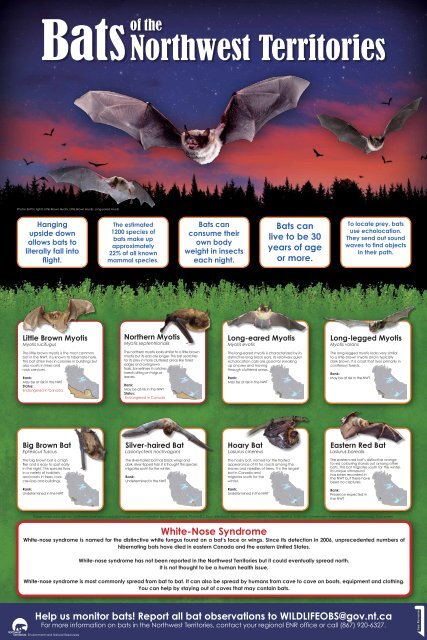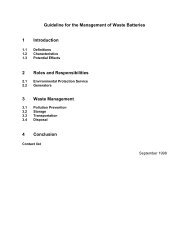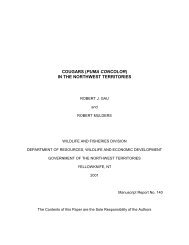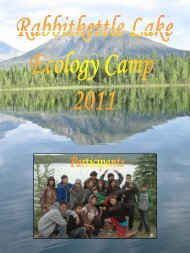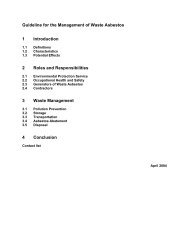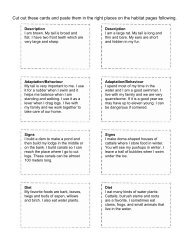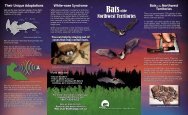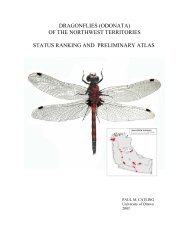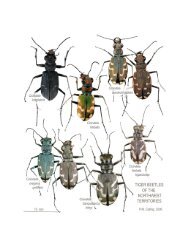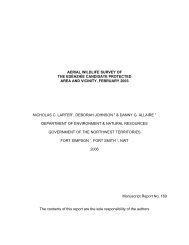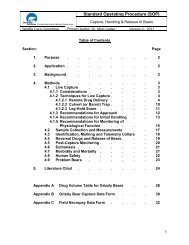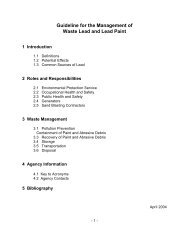Bats of the NWT poster
Bats of the NWT poster
Bats of the NWT poster
You also want an ePaper? Increase the reach of your titles
YUMPU automatically turns print PDFs into web optimized ePapers that Google loves.
<strong>Bats</strong><br />
<strong>of</strong> <strong>the</strong><br />
Northwest Territories<br />
Photos (left to right): Little Brown Myotis, Little Brown Myotis, Long-eared Myotis<br />
Hanging<br />
upside down<br />
allows bats to<br />
literally fall into<br />
flight.<br />
The estimated<br />
1200 species <strong>of</strong><br />
bats make up<br />
approximately<br />
22% <strong>of</strong> all known<br />
mammal species.<br />
<strong>Bats</strong> can<br />
consume <strong>the</strong>ir<br />
own body<br />
weight in insects<br />
each night.<br />
<strong>Bats</strong> can<br />
live to be 30<br />
years <strong>of</strong> age<br />
or more.<br />
To locate prey, bats<br />
use echolocation.<br />
They send out sound<br />
waves to find objects<br />
in <strong>the</strong>ir path.<br />
Little Brown Myotis<br />
Myotis lucifugus<br />
Nor<strong>the</strong>rn Myotis<br />
Myotis septentrionalis<br />
Long-eared Myotis<br />
Myotis evotis<br />
Long-legged Myotis<br />
Myotis volans<br />
The little brown myotis is <strong>the</strong> most common<br />
bat in <strong>the</strong> <strong>NWT</strong>. It is known to hibernate here.<br />
This bat <strong>of</strong>ten lives in colonies in buildings but<br />
also roosts in trees and<br />
rock crevices.<br />
Rank:<br />
May be at risk in <strong>the</strong> <strong>NWT</strong><br />
Status:<br />
Endangered in Canada<br />
The nor<strong>the</strong>rn myotis looks similar to a little brown<br />
myotis but its ears are longer. This bat searches<br />
for its prey in more cluttered areas like forest<br />
edges and overgrown<br />
trails. Sometimes it catches<br />
insects sitting on twigs or<br />
leaves.<br />
Rank:<br />
May be at risk in <strong>the</strong> <strong>NWT</strong><br />
Status:<br />
Endangered in Canada<br />
The long-eared myotis is characterized by its<br />
distinctive long black ears. Its relatively quiet<br />
echolocation calls are good for sneaking<br />
up on prey and moving<br />
through cluttered areas.<br />
Rank:<br />
May be at risk in <strong>the</strong> <strong>NWT</strong><br />
The long-legged myotis looks very similar<br />
to a little brown myotis and is typically<br />
dark brown. It is a bat that lives primarily in<br />
coniferous forests.<br />
Rank:<br />
May be at risk in <strong>the</strong> <strong>NWT</strong><br />
Big Brown Bat<br />
Eptesicus fuscus<br />
Silver-haired Bat<br />
Lasionycteris noctivagans<br />
Hoary Bat<br />
Lasiurus cinereus<br />
Eastern Red Bat<br />
Lasiurus borealis<br />
The big brown bat is a high<br />
flier and is easy to spot early<br />
in <strong>the</strong> night. This species lives<br />
in a variety <strong>of</strong> habitats<br />
and roosts in trees, rock<br />
crevices and buildings.<br />
The silver-haired bat has black wings and<br />
dark, silver-tipped hair. It is thought this species<br />
migrates south for <strong>the</strong> winter.<br />
Rank:<br />
Undetermined in <strong>the</strong> <strong>NWT</strong><br />
The hoary bat, named for <strong>the</strong> frosted<br />
appearance <strong>of</strong> its fur, roosts among <strong>the</strong><br />
leaves and needles <strong>of</strong> trees. It is <strong>the</strong> largest<br />
bat in Canada and<br />
migrates south for <strong>the</strong><br />
winter.<br />
The eastern red bat’s distinctive orange<br />
to red colouring stands out among o<strong>the</strong>r<br />
bats. This bat migrates south for <strong>the</strong> winter.<br />
Its unique ultrasound<br />
has been recorded in<br />
<strong>the</strong> <strong>NWT</strong> but <strong>the</strong>re have<br />
been no captures.<br />
Rank:<br />
Undetermined in <strong>the</strong> <strong>NWT</strong><br />
Rank:<br />
Undetermined in <strong>the</strong> <strong>NWT</strong><br />
Rank:<br />
Presence expected in<br />
<strong>the</strong> <strong>NWT</strong><br />
Range maps are based on confirmed observations and will change as new information becomes available. Photos © J. Scott Altenbach, Michael Durham/Minden Pictures, Merlin D. Tuttle (Bat Conservation International, www.batcon.org); Cori Lausen.<br />
White-Nose Syndrome<br />
White-nose syndrome is named for <strong>the</strong> distinctive white fungus found on a bat’s face or wings. Since its detection in 2006, unprecedented numbers <strong>of</strong><br />
hibernating bats have died in eastern Canada and <strong>the</strong> eastern United States.<br />
White-nose syndrome has not been reported in <strong>the</strong> Northwest Territories but it could eventually spread north.<br />
It is not thought to be a human health issue.<br />
White-nose syndrome is most commonly spread from bat to bat. It can also be spread by humans from cave to cave on boots, equipment and clothing.<br />
You can help by staying out <strong>of</strong> caves that may contain bats.<br />
Help us monitor bats! Report all bat observations to WILDLIFEOBS@gov.nt.ca<br />
For more information on bats in <strong>the</strong> Northwest Territories, contact your regional ENR <strong>of</strong>fice or call (867) 920-6327.
We Humans Have Lots in Common With <strong>Bats</strong>!<br />
Wow! What a Wingspan!<br />
Like us, bats come in many sizes! Some humans are over 2 metres tall while<br />
<strong>the</strong> wingspans <strong>of</strong> some bats are 1.5 metres. Some humans are only 59 cm tall<br />
and <strong>the</strong> smallest bats have a wingspan <strong>of</strong> only 12 cm.<br />
Home Sweet Home!<br />
Not all humans live in houses. Some live in apartments, some live in<br />
condominiums. <strong>Bats</strong> are similar. Some roost in trees, some roost in caves,<br />
some roost in cracks and crevices in cliffs. But some like to live in houses.<br />
<strong>Bats</strong> have large wings compared to <strong>the</strong> rest <strong>of</strong> <strong>the</strong>ir bodies. Imagine you are a<br />
bat and <strong>the</strong> same size you are now; how big would your wings be?<br />
Materials:<br />
• Tape measure<br />
• Craft paper, flip chart paper, cloth (optional)<br />
Directions:<br />
• Measure how tall you are.<br />
• Multiply that by 3.<br />
• That’s how big your wingspan would be if you had bat’s wings.<br />
• Make yourself a pair <strong>of</strong> life-sized wings.<br />
(Hint: easy Hallowe’en costume!)<br />
If you want to attract local bats, why<br />
not build a bat house? Remember<br />
though, to meet <strong>the</strong> needs <strong>of</strong> bats in our<br />
cool climate, houses should be:<br />
• Fully caulked and unvented<br />
• Multi-chambered<br />
• Painted or stained a dark colour to<br />
absorb sunlight<br />
• Mounted high on <strong>the</strong> south facing<br />
wall <strong>of</strong> a building<br />
Be patient. It may take a year or two<br />
for bats to discover and live in a new<br />
house, but <strong>the</strong> wait will be worth it.<br />
Happy bat viewing!<br />
Find out how to build your bat house at:<br />
www.batcon.org.<br />
Materials:<br />
• Blindfold<br />
<strong>Bats</strong> Make Sense!<br />
Like us, bats have eyes, ears, teeth, a mouth, a nose and body hair (fur).<br />
<strong>Bats</strong> use <strong>the</strong>ir hearing to locate objects through a process called<br />
echolocation; <strong>the</strong>y send out sound waves using <strong>the</strong>ir mouth or nose. When<br />
<strong>the</strong> sound hits an object, an echo comes back to <strong>the</strong> bat’s sensitive ears.<br />
The bat can identify an object and can even tell <strong>the</strong> size, shape and texture.<br />
Most bats use echolocation to find <strong>the</strong>ir way in <strong>the</strong> dark and to find food.<br />
Instructions:<br />
• Choose someone to be <strong>the</strong> “bat”.<br />
• Blindfold <strong>the</strong> child.<br />
• The rest <strong>of</strong> <strong>the</strong> group will be “insects” (bat food).<br />
• Insects spread out randomly around <strong>the</strong> bat within <strong>the</strong> designated<br />
boundaries.<br />
• Bat calls out “beep, beep”.<br />
• The insects respond with “buzz, buzz” as <strong>the</strong>y walk around <strong>the</strong> area.<br />
• The bat continues to call out and <strong>the</strong> insects continue to respond while<br />
changing positions.<br />
• The bat tries to tag an “insect” by listening for <strong>the</strong> sounds <strong>the</strong>y make and<br />
moving in <strong>the</strong> direction <strong>of</strong> those sounds.<br />
• A tagged “insect” must go sit in <strong>the</strong> “bat cave” (designated area) until <strong>the</strong><br />
next round.<br />
• The last person tagged becomes <strong>the</strong> new “bat”.<br />
What’s for Dinner?<br />
<strong>Bats</strong>, like humans, enjoy a varied diet. We wouldn’t want to eat green beans<br />
every day for every meal. <strong>Bats</strong> like a range <strong>of</strong> foods too.<br />
<strong>Bats</strong> are found around <strong>the</strong> world and different species eat foods such as fruit,<br />
nectar, insects, and even fish, frogs and small mammals.<br />
In Canada, most bat species prefer insects: moths, wasps, beetles, gnats,<br />
midges, mayflies and - lucky for us! - mosquitoes.<br />
Materials:<br />
• Pencil/pen, paper, calculator<br />
Directions:<br />
• Find out how many mosquitoes a little brown myotis can eat during one summer.<br />
• A little brown myotis eats approximately 4 grams <strong>of</strong> insects in one night.<br />
• About 20% <strong>of</strong> a little brown myotis’ food consists <strong>of</strong> mosquitoes.<br />
• A mosquito weighs approximately 2.2 milligrams.<br />
• The mosquito season lasts approximately 90 days.<br />
Hint:<br />
• You need to convert grams to milligrams.<br />
Answer:<br />
• 4 g <strong>of</strong> food per night x .20 (% <strong>of</strong> mosquitoes in diet) = .80 grams eaten/night<br />
• .80 x 1000 (1000 milligrams per gram) = 800 milligrams<br />
• 800 milligrams / 2.2 milligrams per mosquito = 364 mosquitoes eaten/night<br />
• 364 x 90 (# <strong>of</strong> nights) = 32,760 moquitoes eaten each summer! Thank you, Bat!<br />
Can you ‘sniff’ out your young?<br />
Materials:<br />
• Cotton Balls<br />
• Blindfolds<br />
• A variety <strong>of</strong> scents:<br />
• Cinnamon<br />
• Cloves<br />
• Mint<br />
I Can Smell You!<br />
Humans and bats are mammals and share a number <strong>of</strong> traits. Both<br />
bats and humans give birth to living young and feed <strong>the</strong>m on milk from<br />
mammary glands. Many mo<strong>the</strong>r mammals use sight, sound, taste and smell<br />
to recognize <strong>the</strong>ir young. But in a dark cave environment, mo<strong>the</strong>r bats<br />
probably identify <strong>the</strong>ir young by using sound and scent.<br />
• Vanilla<br />
• Lemon<br />
• O<strong>the</strong>r scents<br />
Directions:<br />
• Select five people to be mo<strong>the</strong>r bats and five people to be pups.<br />
• Give each pup a cotton ball with a different scent.<br />
• Give each pup a different call (such as a simple tongue-click).<br />
• Mo<strong>the</strong>rs and pups should practice smelling, calling and hearing.<br />
• Mo<strong>the</strong>rs are blindfolded.<br />
• Pups are scattered around <strong>the</strong> room and remain stationary.<br />
• Only mo<strong>the</strong>rs can move.<br />
• Extra people play <strong>the</strong> part <strong>of</strong> pups but without a smell or call.<br />
• Mo<strong>the</strong>rs enter room and try to find <strong>the</strong>ir babies who call for <strong>the</strong>m and place cotton<br />
balls up to <strong>the</strong> nose if any mo<strong>the</strong>r bat comes close.<br />
• Winner is <strong>the</strong> first mo<strong>the</strong>r and pup to find each o<strong>the</strong>r.<br />
• Keep game going until all pairs find each o<strong>the</strong>r.<br />
• Reverse <strong>the</strong>ir roles and let o<strong>the</strong>rs try <strong>the</strong> activity.<br />
• Discuss how <strong>the</strong> mo<strong>the</strong>rs were able to find <strong>the</strong>ir pups.<br />
Materials:<br />
• Pine cone<br />
• Construction paper<br />
• Thin wooden skewers<br />
• Googly eyes<br />
• String/yarn/fishing line<br />
• Glue<br />
Let’s Give <strong>Bats</strong> a Hand!<br />
Like us, bats have hands and fingers! <strong>Bats</strong> belong to <strong>the</strong> order Chiroptera,<br />
which means “hand-wing” in Greek. A bat’s wing consists <strong>of</strong> an arm that ends<br />
in a wrist with a thumb and four separate fingers which are webbed with skin<br />
and form <strong>the</strong> ribs <strong>of</strong> <strong>the</strong> wing. When bats extend <strong>the</strong>ir arms and spread <strong>the</strong>ir<br />
fingers, <strong>the</strong>ir wings are ready for flight. By shaping <strong>the</strong>ir “hands” <strong>the</strong>y control<br />
<strong>the</strong> shape <strong>of</strong> <strong>the</strong>ir wings. Make a bat mobile to see what a bat’s wing is like!<br />
Directions:<br />
• Cut out wings from<br />
construction paper.<br />
• Tape or glue sections <strong>of</strong><br />
skewer stick onto wings to<br />
make fingers.<br />
• Glue wings on to <strong>the</strong> pine cone body <strong>of</strong> <strong>the</strong> bat.<br />
• Glue googley eyes on.<br />
• Attach string/yarn/fishing line to hang.<br />
Forearm<br />
Ulna Radius<br />
Humerus<br />
Wrist<br />
Fifth<br />
Finger<br />
Thumb or<br />
First finger<br />
Index or<br />
Second finger<br />
Fourth<br />
Finger<br />
Third<br />
Finger<br />
<strong>Bats</strong><br />
<strong>of</strong> <strong>the</strong><br />
Northwest Territories<br />
Images courtesy <strong>of</strong> Bat Conservation International, Government <strong>of</strong> Yukon and Arizona State Parks. Content adapted from Bat Conservation International.


